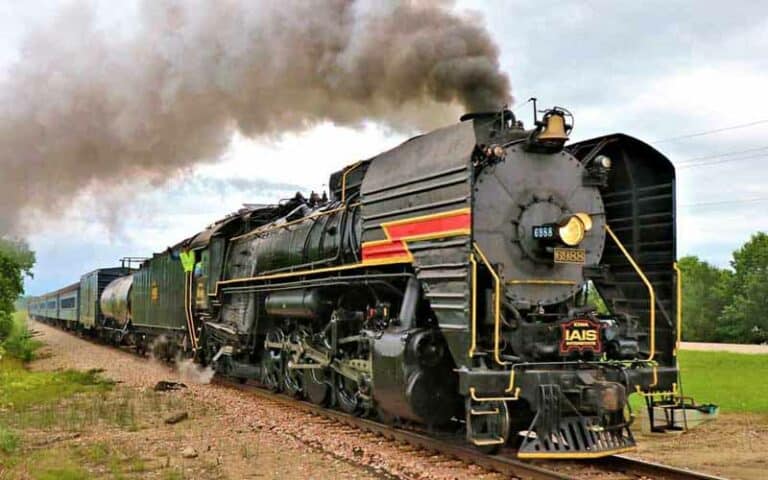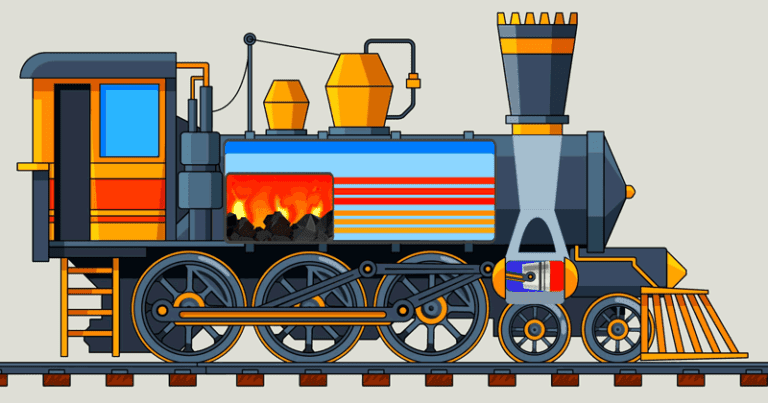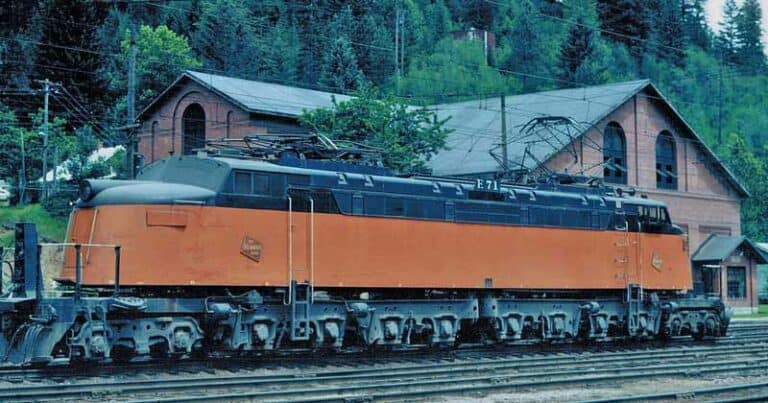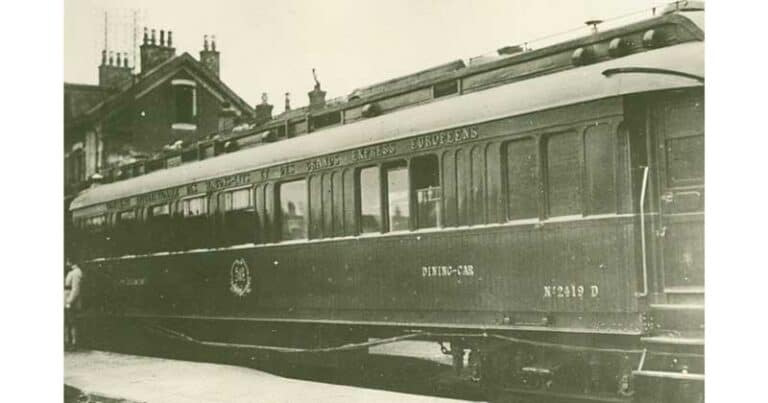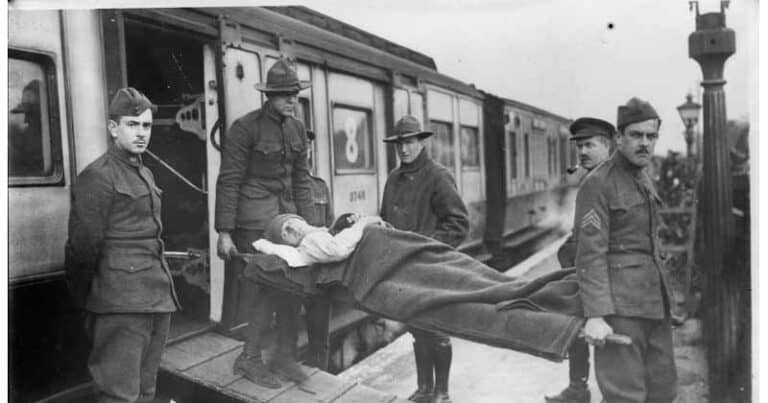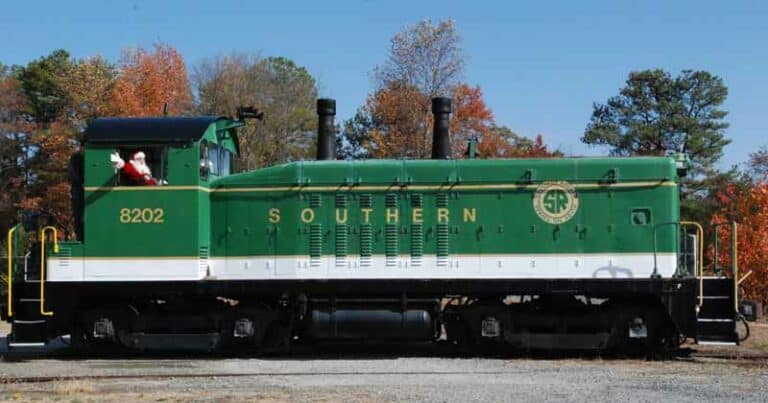Common Steam Locomotive Questions Answered
We get questions via email and social media.
Some we can even answer. 🙂
We try to answer every question as best we can. Most of the time we got ya’ covered, occasionally the questions are just too technical. Take a look at the questions and answers we’ve already answered:
Why is there a diesel with the steam locomotive?
Please believe us when we say the diesel is not there because the steam engine can’t pull the train. The steam engine is designed to, and can easily pull, much more than the few passenger cars running behind today. However there are several good and logical reasons that the railroad deemed it necessary to include a diesel in the lineup.
As modern as these fully operational, fully restored steam engines are – and they often represent the pinnacle of the steam designer and manufacturer’s art – they do not include dynamic brakes. A quick simplistic explanation of dynamic brakes: they use the kinetic energy of the engine to create electrical energy which can be applied to a modern traction motor to slow the locomotive. So, no dynamic brakes.
The diesel uses its dynamic braking to save wear and tear – very expensive wear and tear – on the steam engines brake shoes. Steam engine brake shoes are no longer available nor installed at just any railroad shop, as they were “back in the day”. When running a train down 1.77% grades (The Wasatch Grade in Utah) those dynamic brakes could save hundreds of thousands of dollars in brakes servicing.
The Union Pacific uses its very expensive steam program as a public relations and customer/shipper relations program. The diesel is a part of that effort. Notice the diesel being used is not just “any old diesel”. The diesel in this train has been especially chosen. It is a newer, modern unit. It is often a “heritage” unit which honors part of the railroad’s past.
Union Pacific uses the steam engine as a draw for the public and shippers and the media, but wants them also to see how modern the railroad is as well. So, they always include a new, clean diesel. It’s the same reason Union Pacific always includes a multimedia exhibit car about the railroad.
And, let’s face it the diesel is a life-line, a life-preserver if you will. Although we know of no recent mainline steam excursion where the diesel had to rescue the steam engine, it is a possibility. These locomotives are amazing machines, some of which are approaching 100 years old. Some railroads allow steam engines, such as Nickel Plate 765, on their rails, but only if backed up by a diesel.
A busy railroad can’t have a major mainline tied up for hours – or more – while an off the schedule passenger train sits and sits. So, it’s a fact of life. The bottom line may be this: Do you enjoy seeing Big Boy 4014 running those 4-8-8-4’s on the main? Do you like seeing the speed demon N&W 611 tearing up the rails at 70mph? Or Nickel Plate Berkshire 765 re-living the 1950s for us? Yes? Then we may have to ignore the diesel in the consist. It’s a trade most steam fans are willing to make.
I think the diesel is pushing the steam engine
If you think the diesel is included because it is “pushing” the steam engine, that the steam locomotive is faking it. Well, you’re just wrong, but to each his own.
The idea that organizations/railroads would spend millions of dollars, tie up their mainlines, invite the media and the public to these events – just to try to fake it before thousands of knowledgeable railfans and railroaders just defies logic and common sense.
I think that steam engine is faking it. There’s no smoke!
There is exhaust… look carefully. You have to remember 1) many of our currently running steam locomotives, including Big Boy, now burn oil, so there is much less smoke and 2) smoke is what we see after an inefficient burn of fuel.
Smoke is the particulate fuel that did not burn, and now comes from the stack. A good engineer strives to run the locomotive lean and burn fuel efficiently. Also, look at the grade. Is the locomotive coasting down grade or on level track? No need to pour on the fuel, so no smoke.
“Gee one steam engine could pull that train by itself”
There is no doubt that one Big Boy, or one Allegheny could pull as much as two or three or more modern diesels. But diesels did not replace steam because they were more powerful.
There were many reasons including economics, maintenance, manpower, comfort, environmental issues, efficiency and more. Even then, it often took two or three steam locomotives, back in the day to do the job of one Challenger or Big Boy. As much as we love the steam locomotive, the many economical advantages of the diesel locomotive were always going to rule the future of railroading.
Hey, Big Boy is a HE! Why do you call Big Boy a SHE?
It’s an odd thing that a locomotive named “Big Boy” is properly referred to as “She” or “Her”, but it is true. 🙂 The reason is lost to history, but large ships, boats and locomotives are referred to as “her”. The English language is quirky and this is one of those quirks.
To start with a reference you are probably aware of, all ships are referred to as females. It is a long naval tradition explained this way by the United Kingdom’s Imperial War Museums, “Although it may sound strange referring to an inanimate object as ‘she’, this tradition relates to the idea of a female figure such as a mother or goddess guiding and protecting a ship and crew. Another idea is that in many languages, objects are referred to using feminine or masculine nouns. This is less common in English which tends to use gender-neutral nouns, however referring to ships as ‘she’ may refer to far more ancient traditions.”.
The US Navy always refers to ships as “she” or “her”, yes, even when the name is a male name. The USS Ronald Reagan is a “she”. It just is. Rear Admiral Francis Foley (Retired) writes for the US Naval Institute and has a more emotional argument than the Imperial War Museums, he says, “Ships are referred to as “she” because men love them, but this encompasses far more than just that.” Admiral Foley continues on to say a good ship acts like a woman and will take care of a sailor.
But our subject is locomotives. Well again, we can begin in the United Kingdom with another example of this oddity. The Sir Nigel Gresley is a celebrated restored steam locomotive, note the use of “her” and “she when referring to the locomotive, even though obviously named after a man, on the North Yorkshire Moors Railway website. The Sir Nigel Gresley is a 4-6-2 streamlined locomotives, built in 1937.
But, maybe the article you are looking from comes from the late Trains Magazine editor Jim Wrinn, “Is a Big Boy Locomotive a he or a she?” Spoiler, Jim doesn’t come to any conclusions.
For a deep, deep dive into the English language and this subtopic of our crazy language, read “Metaphorical Gender in English“. They take a look at the use of gender in vehicles, tools and even “Mother” Earth. This group ends up advocating for gender neutral terms for all inanimate things.
If none of that fails to convince you that in the English language Big Boy is properly referred to as “her” and “she”, how about thinking of Union Pacific Big Boy 4014 as a Big “Tom” Boy. 🙂
Is (or when is) Big Boy coming to _______?
The Union Pacific Railroad, owner and operator of Big Boy 4014, owns railroad lines that span the western United States. Their owned lines do not extend east beyond Chicago, Memphis and New Orleans. While there has been no official statement from the UP, it is unlikely that the Big Boy will venture off Union Pacific owned rail lines.
It’s not impossible that the Big Boy will venture east, just unlikely. Union Pacific did send, at the request of CSX, the Challenger locomotive east to pull a special “Santa Train” through the Appalachian Mountains of Kentucky and Tennessee. That was in 1992, and still remembered as a momentous event in steam history. So, Big Boy East of the Mississippi River could happen, just unlikely.
So how do you find out where Big Boy 4014 is now, or will be on one of its tours? Here are three ways:
Of course, you can always follow SteamGiants on Facebook. We’ll update the location every day when Big Boy is on tour.
Union Pacific maintains a Steam Locomotive Tracking page. It will often show the locomotives at home in Cheyenne, Wyoming, but if traveling will update their location hourly.
And, you should sign up for the Union Pacific Steam Club email.
Is Big Boy burning coal or oil?
4014 was built as a coal burner. During her restoration, she was converted to oil. Coal was delivered by an auger mechanism, the oil by a pipe. Both 4014 and Union Pacific 844 now run on oil for fuel. That is what the extra tenders behind the locomotives are hauling. It easier for the UP to fuel up off-site when the locomotives travel. The oil also burns cleaner and won’t give off sparks, plus the oil is generally more environmentally friendly.
Will Challenger #3985 be running again?
Good news! The plan is to have CHallenger 3985 running under her own power again. Union Pacific made it possible, but they will not be doing the work. UP donated Challenger 3985 to the same group that runs Milwaukee Road 261 – so these folks know how to restore and operate a steam locomotive these days.
Now, it is going to be a difficult job. And this group is asking for donations. You can donate at their website. The donation of 3985 – and another long retired Union Pacific locomotive was announced in April, 2022. Union Pacific has promised to deliver the locomotive as soon as operations allow.
Union Pacific Challenger 3985 is a giant 4-6-6-4 of a powerhouse and this won’t be her first restoration to running condition. She restored to operational service in 1981. She spent many years thrilling fans as the largest operating steam locomotive in the world. She pulled many excursions and even freight trains during those years.
But time had taken its toll and she was shopped in Cheyenne at the end of the 2010 season. A year after Big Boy 4014 ran to Ogden Utah for the celebration of the 150th Anniversary of the joining of East and West by the Transcontinental Railroad, Union Pacific announced a well earned retirement in January, 2020.
Union Pacific steam program manager, Ed Dickens, said that the Steam Team felt that maintaining three historical steam locomotives at the same time would be too much to handle. The locomotive also required a complete, from the ground up, rebuilding because of its poor mechanical condition. So Big Boy 4014, a huge 4-8-8-4 steam locomotive officially replaced Challenger 3985 in Union Pacific’s Cheyenne Steam Shop, right next to UP 844.
The donation of 3985 to a group with the resources to restore her is another sign that Union Pacific remains committed to the preservation of railroading history – even in the 2020s and beyond.
Why music on this video? I want to hear the train!
Well yeah, so would we! 😉 The fact is that recording of audio out in the field during the days of steam was not simple at all. Recording of audio alone meant big bulky equipment, and more than that if you wanted stereo. And steam in stereo is the way to go!
When film became sorta affordable for amateurs, those film cameras did not include sound. Much fantastic steam footage was shot on 8mm, but it was not until 1960 that even the most expensive 8mm camera could record sound. Super 8 film, with sound on film, was not available until 1973.
16mm film camera were available with sound capability for the home market as early as the mid 1930’s, but the “sound on film” film was both dangerous (highly flammable and expensive until Kodak’s Kodachrome became widely available in the late 1930s. Still sound film was very expensive. World War 2 brought prices down as the demand for 16mm sound film equipment and film reduced manufacturing costs. It’s why we see far more good 1950s and 1960s sound films of steam and early diesel.
If you couldn’t afford sound film or sound film equipment, but still wanted sound, or wanted better sound that the simple mono film sound of the time, you could take your hobby to another level by carrying those bulky audio recording devices with your film cameras into the field. You could in that way get wonderful sound of what you were filming, but marrying the two together was very difficult. It’s a lot easier now and so some sound and film are being matched and brought together for the first time!
But the fact is, not all film had sound, or sound that was taken at the same time. And so much of the marvelous images of steam that we see today uses dubbed steam sounds. A proder who uses the same type of locomotive and has a good ear can make the audio nearly perfect and it enhances the wonderful images.
Some producers have decided not to do that work, or have decided it is more “pure” not to dub in steam sounds, so have chosen a music background, with mixed results. With or without sound, let’s appreciate the images of these wonderful machines, now mostly gone, as they worked during a time when they were ubiquitous. And, if the music bothers you, mute the audio! 🙂
Isn’t that a lot of Pollution?
Are we talking about steam locomotives or the currently predominant diesel locomotives? Of course steam locomotives are primarily a thing of the past. Yes, when there were thousands of them operating across the nation on a daily basis, they were no doubt a pollution danger.
New York City blamed several accidents on the smoke and steam from hundreds of steam locomotives. The State of New York passed a law in 1903 that banned steam locomotives on Manhattan south of the Harlem River after June 30th, 1908. To this day all underground transit in NYC is electric.
The few remaining steam locomotives in use today are used on tourist railroads and are regulated by the federal government. The large touring locomotives such as Union Pacific Big Boy 4014 burn fuel oil, not coal, and while do smoke, are much more environmentally friendly with smaller particulate matter and much of what comes out of their stack being steam.
Finally, even though there is some smoke and “pollution” from these steam locomotives, these are historic machines that help tell an important story of this nation’s past.
Modern railroads are a much different, and evolving, story. Mile for mile, ton for ton, Railroads are the most environmentally responsible way to transport ground freight. On average, railroads are three to four times more fuel efficient than trucks on a ton-mile basis. A railroad can move one ton of freight 444 miles on a single gallon of diesel fuel, generating a carbon footprint up to 75% less than trucks, according to the Association of American Railroads (AAR).
A train can carry as much freight as 300 trucks, helping to relieve congestion and reduce the strain on busy roads and highways. While some may say a train should be powered with an environmentally friendly electric locomotive, the logistics of how the electricity gets generated will remain a problem. Even Amtrak’s electrified Northeast Corridor uses fossil fuels to generate the electricity.
Batteries and non carbon emitting sources of power are still a ways off from being practical in such an application as heavy freight railroading in North America. However, that doesn’t mean industry and railroads aren’t working the problem. See the article on the new WABTEC battery powered locomotive on our sister website at RaiflanDepot’s blog.
How do engineers keep steam engines the same speed?
When more that one steam engine is required to move a train, either double-headed (two engines at the head end) or with a helper (pusher engine at the rear) service, the most important and common method for keeping the steam locomotives working in sync is just plain ol’ experience.
A good engineer knew his territory and knew how to read the “feel” of the train. It was important for a steam locomotive engineer to be able to “feel” and respond to subtle changes in train speed. This was even more important for engineers who worked in helper service.
There were times when engineers could see each other and used hand signals. Otherwise whistle signals could be used to communicate between engines, though this was not always practical, depending on the length of the train and environmental conditions. Of course, in steam days, a full crew was required in each cab. Today’s trains only require on crew in the lead diesel engine.
How do diesel locomotives work in sync?
Today’s trains do not require a crew, or even one engineer in each cab. The work of one crew can be passed through to each locomotive in the train. Unlike the steam locomotives of the past, diesel locomotives can be connected in line to essentially operate as one using a system known as MU-ing or MU-ed. “MU” stands for multiple unit.
MU cables carrying the operating functions of one locomotive are connected to the other locomotives in the consist, allowing them all to be operated as one from a single locomotive, usually, but not always the lead engine. In fact a series of four 3,000 horsepower engines connected together can be considered “one” 12,000 horsepower “unit”.
That track really should be maintained better
The condition and maintenance level of a railroads track is determined by the needs of the railroad. What may appear to be poorly maintained dangerous track is more than sufficient and safe (at the proper speed).
A railroad line that sees frequent, heavy trains at high speeds is going to be maintained at an appropriate level. A railroad line that only hosts a minimal amount of traffic that it moves at slow speeds has no need for such an investment. It would be overkill. Then there is every situation in between the two extremes.
Every railroad is different as are the tracks they operate on. However, economics may also play a part in the condition of the tracks. In some cases of bad track, when a small or struggling railroad is burdened with poor track conditions, there is little that can be done other than decreasing train speeds until money is available to invest in infrastructure improvement.
Why are there so many kinds of locomotives?
Freight railroads in North America face a huge assortment of variables. Routes can be over many types of terrain and trains have become longer and heavier since even before steam era ended. The challenge for railroads is to give the trains the power needed to do the job. Calculating tonnage and grades and a required track speed all play a part in determining how many engines will efficiently be needed to move a train.
A relatively light priority intermodal train may get more engines simply because it needs to move as fast as possible from point A to point B. A super heavy coal or other bulk commodity train may get assigned a lot of engines to eliminate the potential of stalling on a grade and to keep the railroad line that it travels on fluid, reducing delays to other trains. Also different models of engines offer different amounts of horsepower, factoring into the railroad’s decision on how many are needed for the job.
Finally, don’t assume that all the engines you see on a train are in use. Many times a railroad will add them to a train just to get them to a major servicing facility or to balance the power. (More engines are needed for eastbound trains because they are mostly loads and have to climb steeper grades, etc)
What kind (or model) of engine is that?
Even though our work revolves around railroads and locomotives we can’t identify many, or even most locomotives by sight. There are so many models, especially when you include locomotives of the past. And each model of locomotive may have many variants.
However, we do know how you can almost always find out the information. In our years of using the internet as an invaluable reference tool, we have discovered that one of the easiest ways to identify a locomotive is by using Google or your favorite search engine.
Type in the name of the railroad and the engine number. A random example would be “Delaware & Hudson #1216”. This search not only provides pictures, but identifies the engine as a Baldwin Locomotive Works RF-16A. We are lucky to live in an age where such information is at our fingertips.
Why is that engine going/facing backwards?
A diesel engine is designed to operate the same no matter which direction it faces. While normally the front of the engine is the “cab”, where the crew will operate it from, there are no hard rules about which way the cab has to face.
Using a control on the engine called a reverser, the engine can be told in which direction the wheels will turn based on the control of the engineer. In other words, in a set of two engines pulling a train eastward, with the lead engine’s cab facing east and the trailing engines cab facing west, the trailing engine will mimic the direction of the lead engine as long as the reverser position is set.
Often you will see a train with several engines facing in different directions. It is irrelevant as long as the reverser controls in each are set properly. Finally a trailing engine that is facing west on an eastbound train may very well become the lead engine on another train that is going to go west.


